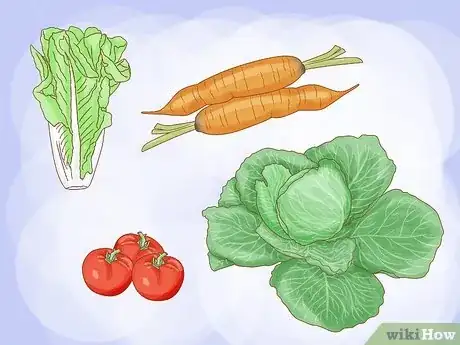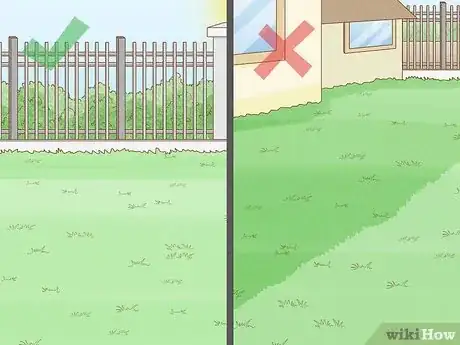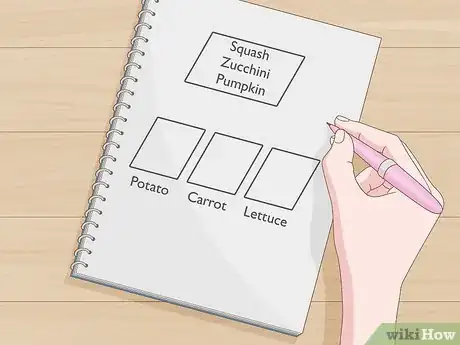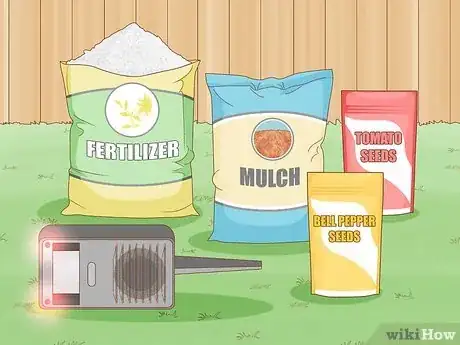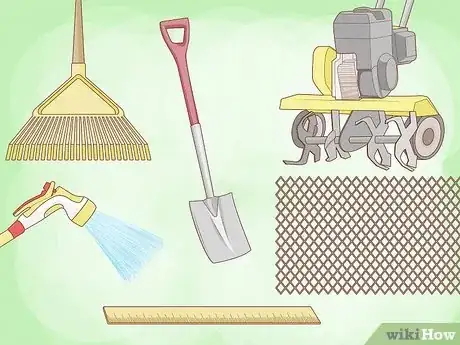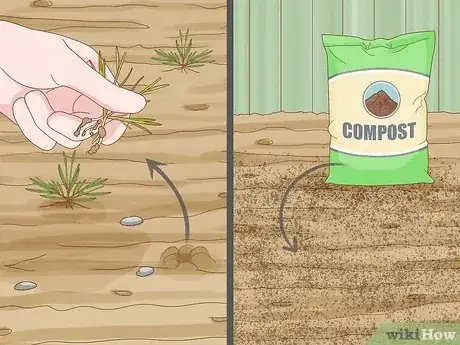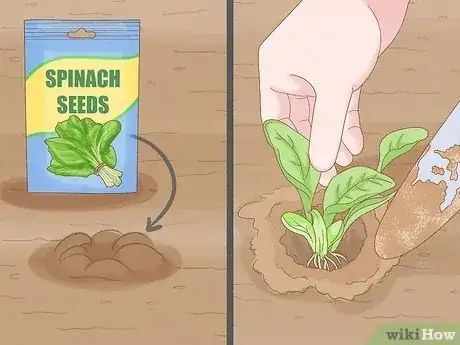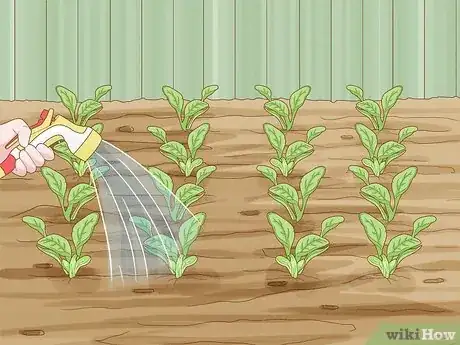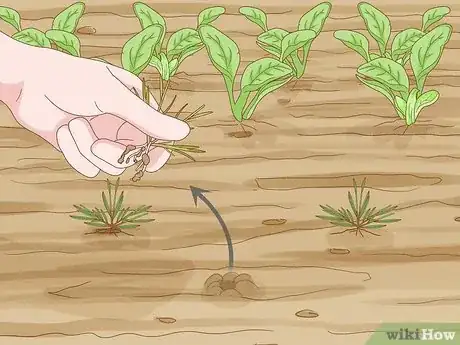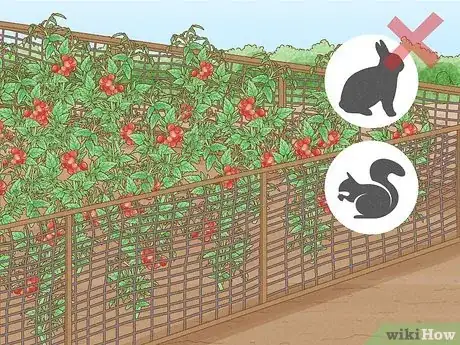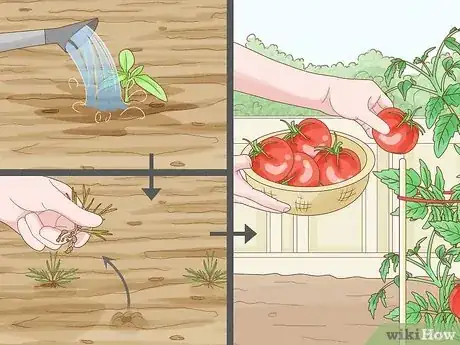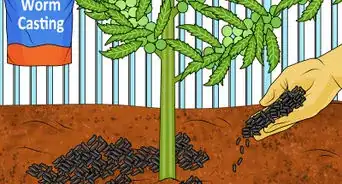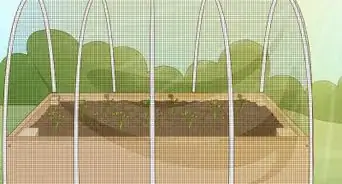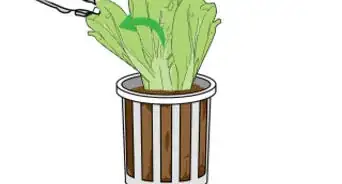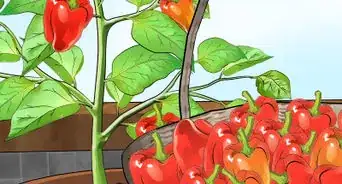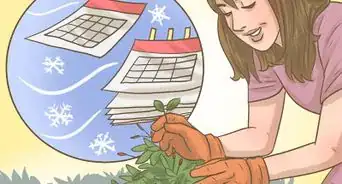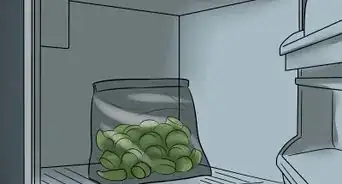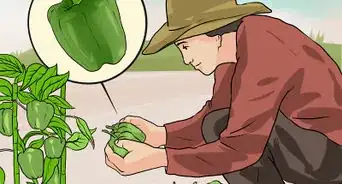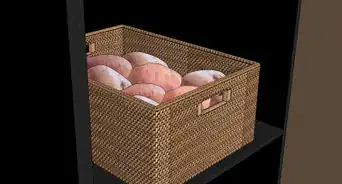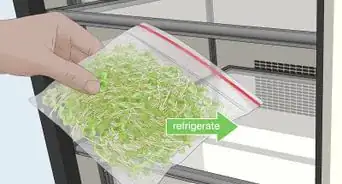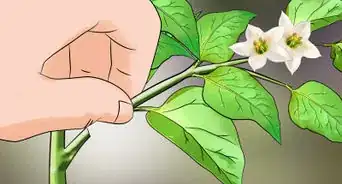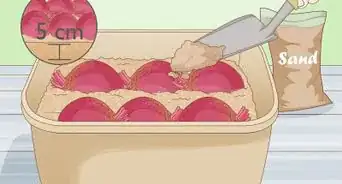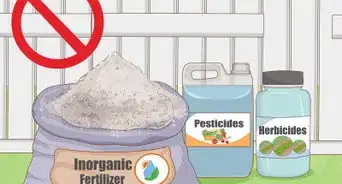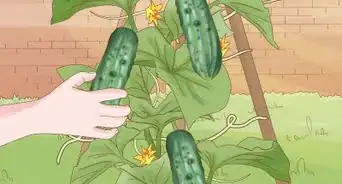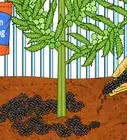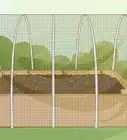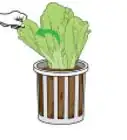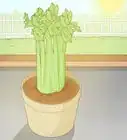This article was co-authored by Ben Barkan. Ben Barkan is a Garden and Landscape Designer and the Owner and Founder of HomeHarvest LLC, an edible landscapes and construction business based in Boston, Massachusetts. Ben has over 12 years of experience working with organic gardening and specializes in designing and building beautiful landscapes with custom construction and creative plant integration. He is a Certified Permaculture Designer, is licensed Construction Supervisor in Massachusetts, and is a Licensed Home Improvement Contractor. He holds an associates degree in Sustainable Agriculture from the University of Massachusetts Amherst.
This article has been viewed 110,046 times.
Creating a vegetable garden is a fun and rewarding experience. Grow delicious vegetables your family likes to eat. Find the best place in your yard to plant vegetables and with a little time and care, your dinner table will overflow with healthy, ripe vegetables.
Steps
Planning the Garden
-
1Decide what to grow. What vegetables do you like to eat? Think about which vegetables you'd like to eat each season that also grow in your climate. Then plan your vegetable garden accordingly. Most vegetables grow well in a variety of different climates, but it's a good idea to learn what grows best in your region's garden zone before deciding what to plant.[1]
- Choose vegetables that can be harvested at different times. This way, you'll have produce all summer instead of all at once.
- Some plants don't grow well in certain regions. Find out if the vegetables you want to grow require a cold snap to get started, or if they'll wither and die when the temperature gets too hot. You might have to be selective about what you grow if you live in a climate with very short summers or an area that doesn't get much water.
- Choose plants with similar growing and soil conditions to make it easier to care for your vegetable garden.
-
2Select a garden area. Vegetables need strong, full sunlight, so choose the sunniest part of your yard to create your vegetable garden. Avoid areas that are shaded by your house or a tree during part of the day. Choose a spot with good drainage and rich soil.
- You determine if an area has good drainage by checking it after a heavy rain. If a puddle forms, that area is probably not suitable for a vegetable garden. If the water seeps into the soil quickly, it should be fine.
- Choose a flat area without roots and rocks. This will be much easier to till the soil to prepare the garden for planting.
- If your soil doesn't have good drainage, you can create a raised bed which allows plants to grow above ground level.
- Some vegetables grow well in large pots, too. If you don't have a yard, peppers, okra, tomatoes and potatoes can all be grown in pots on a patio or fire escape.
Advertisement -
3Design the garden. Now it's time to figure out how much space the garden should take up, and where to place vegetable plants. Different vegetable plants require different amounts of space. Figure out how much space you will need for the plants.
- You need to know how much space to leave between the seeds or seedlings you plant, as well as how much space the mature plants will take up. Squash, zucchini and pumpkins take up a lot of space and produce a lot of fruit, while potatoes, carrots and lettuces stay relatively contained.[2]
- Planting vegetables in rows helps you keep track of which plants are which.
- Factor in extra space between the rows to allow you to walk into the garden to weed, fertilize, and water it, as well as to harvest ripe vegetables.
Getting Ready to Plant
-
1Buy seeds and supplies. Choose whether to start your garden from seeds or sprouted seedlings. Purchase from a catalog or nursery. You will also need to determine which garden tools to buy. Gardening can be done by hand with simple tools, but a very large garden may require a tilling machine to loosen the soil.[3] Here's what you'll need:
- Seeds or seedlings. Nurseries have good selections of seeds and seedlings and staff who can help you decide which varieties to buy.
- Fertilizer. A good natural fertilizer will boost your vegetable plants. Work bone meal, blood meal or fertilizer into the soil. Compost works well.
- Mulch and topsoil. Vegetable plants need to be protected from wind and heavy rain when first planted. Use mulch or simply a fine layer of topsoil. You could cover the soil with loose hay to protect sprouting plants.
- Pest deterrents. It's a good idea to also purchase products that combat disease and pests.
-
2Use a soil tiller or hoe to loosen the dirt and prepare your plot.[4] Doing this will loosen the dirt, allowing you to add fertilizer and dig holes for the vegetable plants. For a small garden, simply use a hoe, but for large gardens more than 10 square feet, you may want to buy or rent a soil tiller.
- A shovel, a spade, and a garden rake. Use these essential gardening tools to dig holes and to move plants and soil.
- A ruler or measuring tape. Vegetable plants need to be planted at different depths, so it's useful to measure the holes you make with a ruler.
- A hose with an adjustable watering feature. The ability to change the water pressure comes in handy.
- Fencing supplies. Rabbits, squirrels, deer and other animals like to nibble on vegetables, so you may want to construct a fence around your garden.
-
3Get the soil ready. Mark the corners of the garden area with rocks. Clear the area within the borders free of roots, rocks, sticks, weeds, and other large debris. Use the soil tiller, hoe or rake to break up the soil into small pieces, working it to a depth of about 12 inches (30.5 cm), depending on how deep your vegetables need to be planted.
- If you have weeds you know will take over your garden, you can place pieces of cardboard on top of them with a layer of compost on top. This will smother the weeds and leave a fresh slate for your garden.[5]
- Work fertilizer into the soil with a garden rake. Be sure to distribute it evenly.
- Be sure to take the time to remove large rocks buried in the dirt. They'll get in the way of your plants' roots, and it's worth taking the time to clear the area.
- If you're concerned about the quality of the dirt in your yard, buy a soil testing kit to find out how many nutrients and organic matter it contains, as well as its pH level. All of these factors affect the nutrition and growth rate of your vegetables. After you've tested the soil, you can add whatever it might be missing.
Growing the Vegetables
-
1Dig holes and plant the seeds or seedlings.[6] Use the spade to dig holes to the depths required by the various vegetables you're planting. Put a little fertilizer into each hole, then drop the seeds into the holes or gently place the seedlings into them. Cover the holes with topsoil and a layer of mulch, if required.
-
2Water the garden. For the first few weeks, while the vegetables take root, you need to keep the topsoil moist. Use the misting function on your garden hose to lightly spray the garden every day.
- Check the soil often. If it seems to be dry, mist it again.
- Avoid watering the garden at night. If water sits all night without getting absorbed or evaporating, it could cause fungus to grow.[7]
-
3Weed the garden. As the vegetables take and begin to sprout, take notice of non-vegetable plants that may also be taking advantage of the fertilizer and water you're providing. Grasp the weeds close to the roots and gently pull them out, then throw them away in an area away from the garden so their seeds don't spread.[8] Be careful not to pull up newly sprouted vegetables.
-
4Keep critters away. Before the vegetable plants begin to bear fruit, you might want to put up a fence to keep out the rabbits and squirrels. A short chicken wire fence usually does the trick. If you have deer, however, you might need to build something larger.
-
5Care for the vegetables according to their needs. Give the vegetable plants the amount of water, pruning, and fertilizer they require. Continue weeding the garden frequently as the vegetables grow throughout the summer. When it's time to harvest vegetables, pick only the ripest ones first and allow the others more time to grow.
Expert Q&A
-
QuestionWhat are the best veggies to plant now?
 Maggie MoranMaggie Moran is a Professional Gardener in Pennsylvania.
Maggie MoranMaggie Moran is a Professional Gardener in Pennsylvania.
Home & Garden Specialist You can plant any warm-season crops you might have. There is no need to start them indoors as the weather is warm enough.
You can plant any warm-season crops you might have. There is no need to start them indoors as the weather is warm enough. -
QuestionWhat month should you plant vegetables?
 Maggie MoranMaggie Moran is a Professional Gardener in Pennsylvania.
Maggie MoranMaggie Moran is a Professional Gardener in Pennsylvania.
Home & Garden Specialist You should start vegetables about 6-8 weeks before the final frost of the year. This should be done so the vegetables can be planted outdoors in March (in the U.S.).
You should start vegetables about 6-8 weeks before the final frost of the year. This should be done so the vegetables can be planted outdoors in March (in the U.S.). -
QuestionWhat are the best vegetables to plant?
 Maggie MoranMaggie Moran is a Professional Gardener in Pennsylvania.
Maggie MoranMaggie Moran is a Professional Gardener in Pennsylvania.
Home & Garden Specialist Broccoli, peas, beans, and brussels sprouts are some of the best veggies to plant.
Broccoli, peas, beans, and brussels sprouts are some of the best veggies to plant.
References
- ↑ http://www.bhg.com/gardening/vegetable/vegetables/planning-your-first-vegetable-garden/
- ↑ http://www.bhg.com/gardening/vegetable/vegetables/planning-your-first-vegetable-garden/
- ↑ http://www.getrichslowly.org/blog/2009/01/11/7-tips-for-starting-your-own-vegetable-garden/
- ↑ Ben Barkan. Garden & Landscape Designer. Expert Interview. 2 June 2020.
- ↑ Ben Barkan. Garden & Landscape Designer. Expert Interview. 2 June 2020.
- ↑ http://www.mnn.com/your-home/organic-farming-gardening/stories/how-to-start-a-vegetable-garden
- ↑ http://www.mnn.com/your-home/organic-farming-gardening/stories/how-to-start-a-vegetable-garden
- ↑ Ben Barkan. Garden & Landscape Designer. Expert Interview. 2 June 2020.
- ↑ Ben Barkan. Garden & Landscape Designer. Expert Interview. 2 June 2020.
About This Article
To create a vegetable garden, start by loosening the soil using a shovel or rake in the sunniest part of your garden. Additionally, you’ll need to buy seeds and fertilizer from a gardening store or nursery. Then, remove all stones and roots from the garden area before digging holes for the seeds. Make sure that the holes you dig are the correct depth for the seeds you’re planting, then plant the seeds with some fertilizer. Finally, ensure the topsoil of your garden stays damp by misting it with your hose each day while the vegetables take root. For tips on how to weed your garden and how to deal with pests, read on!
